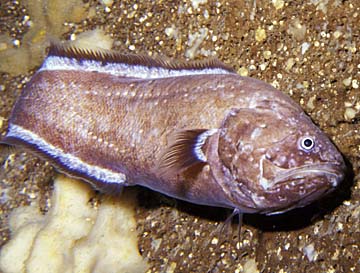
September 12, 2007
Marine biologist Marc Hughes was recently successful in catching a new species of the genus Grammonus, an unusual six inch long brown fish. Hughes had been searching for these fish since he first encountered one of them in 1998, off Hawaii.

The new Hawaiian fish (above) discovered and photographed by Marc Hughes.
The Honolulu Star-Bulletin reporter Rod Thompson writes:
Hughes was studying micro-mollusks that look like sand in the South Kona cave near Kona Paradise subdivision in 1998 when he spotted the unusual fish and took a picture. Another photographer took a picture at about the same time.
The fish had a downturned mouth, and fins along its rear looked similar to an eel. Hugh showed the picture to [John E.] Randall [at the Bishop Museum], who saw it was unusual but could not declare a new species on the basis of a photograph.Hughes ended his nearly decade-long search for a specimen of the fish in April [2007], catching one and sending it to Oahu via a tropical fish dealer.
The fish arrived dead, and the dealer, seeing no value in a dead fish, threw it away. Hughes returned to the cave and caught another one on July 21 [2007].
Shortly after Hughes found his second specimen, biologist Bronson Nagareda caught another one off Waianae and sent it to Randall.
Randall will be writing the scientific paper to get formal recognition and a new name for this fish.
Thompson also notes:
Randall said other Grammonus fish include a species in the Mediterranean and another with the species name Robustus found from Japan through South Asia to the Gulf of Aden at the Horn of Africa.
Randall determined that the Hawaii fish are different partly by X-raying them and counting their vertebrae, different from other Grammonus species.
Grammonus fish give birth to live babies rather than eggs, unusual for marine fish, Randall said.
In other new species news, German biologists have reportedly identified 43 new species of insects and millipedes on the island of Madagascar.
Highlights included eleven new “giant pill millipedes” – some of them were as large as an orange when rolled up – a world record – and were already on earth during the dinosaur era. Among other species found were stick insects, praying mantises and dragon flies.

This huge orange pill millipede is not a new find, but related to the giant pill millipedes recently discovered.
It has been announced that there has been the discovery of two new species of salamanders from the mountainous Costa Rica-Panama border region.

The paratype species of Bolitoglossa gomezi recently discovered in Panama, as photographed by Dr. Alan Jaslow of Rhodes College.
Thanks for the heads up from Wayne Fenner for the fish news.
About Loren Coleman
Loren Coleman is one of the world’s leading cryptozoologists, some say “the” leading living cryptozoologist. Certainly, he is acknowledged as the current living American researcher and writer who has most popularized cryptozoology in the late 20th and early 21st centuries.
Starting his fieldwork and investigations in 1960, after traveling and trekking extensively in pursuit of cryptozoological mysteries, Coleman began writing to share his experiences in 1969. An honorary member of Ivan T. Sanderson’s Society for the Investigation of the Unexplained in the 1970s, Coleman has been bestowed with similar honorary memberships of the North Idaho College Cryptozoology Club in 1983, and in subsequent years, that of the British Columbia Scientific Cryptozoology Club, CryptoSafari International, and other international organizations. He was also a Life Member and Benefactor of the International Society of Cryptozoology (now-defunct).
Loren Coleman’s daily blog, as a member of the Cryptomundo Team, served as an ongoing avenue of communication for the ever-growing body of cryptozoo news from 2005 through 2013. He returned as an infrequent contributor beginning Halloween week of 2015.
Coleman is the founder in 2003, and current director of the International Cryptozoology Museum in Portland, Maine.
Filed under Breaking News, Cryptotourism, CryptoZoo News, Cryptozoologists, Cryptozoology, Forensic Science, New Species, Photos